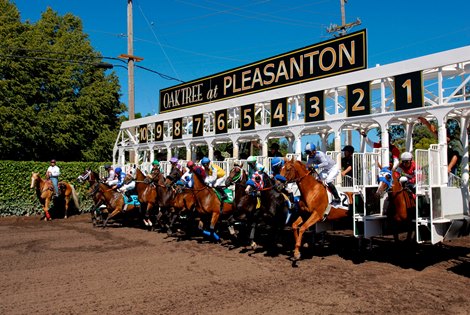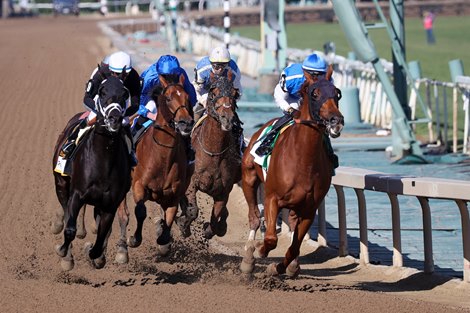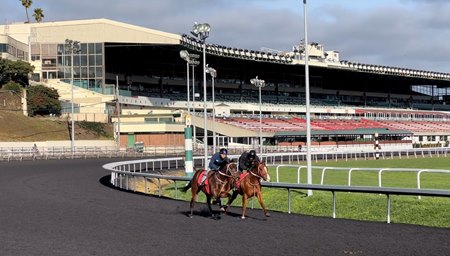Uncertainty has plagued Northern California racing for the better part of a year, if not long before.
Since the July 2023 announcement of the impending closure of Golden Gate Fields, industry stakeholders in the region have questioned what their next steps would be. The roller coaster of emotions may come to a head March 21 as the California Horse Racing Board meets and is scheduled to allocate the remainder of 2024 Northern California racing dates.
Emotions ran high at the Jan. 18 CHRB meeting as Northern California horsemen showed up to voice their desire for continued racing in the north while representatives from the south encouraged a redirection of funds to bolster Southern California purses and increase field sizes there. Plans to preserve racing in the north pitched by the California Association of Racing Fairs were met with skepticism.
"We came out of that meeting stronger than ever," said owner Johnny Taboada. "In this coming meeting, it's not going to be the same. People are not going to be confrontational because they know we have a solution."
One proposed solution is for Pleasanton, which usually hosts a meet in the summer at the Alameda County Fair, to pick up a 26-day fall meet to fill in as the new Golden Gate. Alameda County also is located in the San Francisco Bay Area.
KING: CARF Proposes Continued NorCal Racing at Pleasanton
"When Pleasanton was announced the place to be, the right people were involved," Taboada said. "There have been meeting with the CHRB. The questions they asked have been answered."
"Pleasanton is in a really good area with a lot of money," said trainer Ed Moger Jr. "If they could boost the purses there, at least to start, so that people have something to look forward to, they can get back in business."
Taboada, Moger, and Lindsay LaRoche were the three members of the Thoroughbred Owners of California board who resigned in January due to the TOC's stance on Northern California. TOC president and CEO Bill Nader led the presentation Jan. 18 on the proposed shift to Southern California.
"We were not involved in some of the decision-making," Taboada said of his resignation. "Now that I look back, they knew a long time ago they were going to approach it this way and we were not going to be part of the process."
"It felt like we were wasting our time," Moger said. "I'm not upset with the board, but we had different opinions over what was the right thing for Northern California."
After their departure, Ty Green, John Harris, and Andy Mathis joined the board as Northern California representatives.
"The north needs a seat at the table," Green, an owner and breeder in Northern California, said. "People in the south don't necessarily know the benefits and challenges of racing in the north. I think it is important that they know. My opinion is that we need to bring people together where we can."
The story of California racing, for many years, has been north vs. south. Purses have fallen behind the likes of Kentucky and Arkansas and have recently been cut further to adjust for purse overpayments in the millions.
"We no longer can compete with the purses on the East Coast," Taboada said. "It doesn't mean you have to sacrifice the north to maybe have the possibility of keeping things the same. You're just patching the problem."

In addition, the foal crop has continued to drop in California. In 2003, the state registered 3,867 foals but that figure dropped 66% to 1,319 registered foals in the 2021 crop. There were 5,126 Thoroughbred races in California in 2003 but just 2,815 last year.
"Are we a two-circuit state living in a one-circuit body with racing reduced to three days a week—both in the north and south—and field sizes at an all-time low?" Nader asked at the January CHRB meeting. "Can we continue to support two full-time circuits? This is a fair question."
At the January meeting, the TOC stood on the grounds that condensing racing to the south—outside of the normal fair meets—would help to increase purses and field size. Those supporting the continuation of year-round racing in the north are concerned that condensing in the south could reduce breeding in the state.
"There are a lot of owner/breeders in Northern California," Green said. "There are a number of people that breed to race up north."
Field size has been an ongoing issue in California. In 2023, the average state-wide field size was 7.00.
"Cal-breds fill fields in the south in both open and state-restricted races," Green said. "I'm not sure of the number, but a large percentage of the racing population in the south are Cal-breds."
"What if instead of having 1,300 2-year-old Cal-breds, all of a sudden you have 800 or 900?" Moger said. "They need more people breeding horses, not less."
As the uncertainty has drawn on over the fall and winter, some in Northern California decided not to wait and see what the future holds. Moger has taken a string of 25 horses with him to Santa Anita, with nearly 20 horses remaining at Golden Gate that he's weaning off.
"Owners are getting out of the industry," Moger said. "We had up to 35 mares at our farm that were bred last year; this year we'll be lucky to breed 10."

A telling sign for Moger was when two of his owners, independent from each other, gave away two mares in foal to Clubhouse Ride.
"They both gave the horse away," Moger said. "That's what's going on here."
Moger has bought a farm in Kentucky and, although he's staying in Southern California for now, will start trying his luck further east, as is former Golden Gate leading jockey Evin Roman.
"My dream was always to come (to Kentucky)," Roman said. "The news at Golden Gate, they decided to close the racetrack, so I made the move."
Roman was leading Golden Gate's jockey standings when he made the move in late January. Rather than complete the meet, he decided he needed to take the next step in his career and move on from Northern California sooner than later. Meanwhile, others in Northern California are ready to ride the wave and see what happens.
Matthew Troy trains a small stable of horses, acting as an outlet for horses who can't compete in the south. His clients are owners who purchase horses at sales, and if unsuccessful at the southern tracks, send their horses to Troy in the north for easier competition and different surfaces. A member of the California Thoroughbred Trainers' board, since Golden Gate's announcement of plans to close Troy has been working to keep people informed and answer questions.
"People dig in and have roots here. Kids have school," Troy said. "Do they move? Do they commute? Buy a house, sell a house, rent a new apartment? People ask me those questions all the time, life stuff."
According to Troy, several trainers and many workers at Golden Gate have part-time jobs or work for companies such as Uber and Lyft to make ends meet. He wouldn't be surprised if other people exit the industry due to the financials.
"Owners are going to pay a higher day rate," Troy said of trainers moving to Southern California. "A lot of horses that could run 1-2-3 here might be running 4-5-6 down there, and that's not going to pay the bills."
In addition, the loss of Golden Gate's synthetic and turf courses will remove a large motivation for sending horses north for the fair meetings. If there is no permanent base in the north, the fair circuit could be negatively impacted. Troy noted if connections are going to race on dirt either way, they'll likely stay in the south.
"There's going to be no draw to run in Northern California because there's no synthetic surface," Troy said. "Why would you ship (from Southern California) to run for a $10,000 pot?"
Months of agonizing over the future at the dining room table could soon be temporarily relieved should the CHRB approve fall dates for Pleasanton. Troy believes, regardless of what is to come in future years, allowing racing to stay in the north throughout the remainder of the year is the moral thing to do for those who live and work there.
"The transition (from Golden Gate) is going to be difficult," said Troy. "We just need somewhere soft to land. Make it as easy and convenient as possible. For the stability of people's lives, just get these dates. I think that's fair. If it doesn't seem feasible or doesn't work, you can revamp for next year."
"Why can't they just wait and see if Pleasanton can survive and then make a decision," Moger said. "They're gonna make a run at it. It would be good for California racing if they did."
With The Stronach Group exiting the north, several industry stakeholders see it as an opportunity to improve racing for the future.
"We can have a say in what's coming to the north and lift the racing aspect of it," Taboada said. "Marketing, engaging, something we have not been doing in the north for many years."
The fair tracks have always done well when it comes to attendance. Purses and handle have lagged behind that of Golden Gate, but now that the fairs will be in control of the region, marketing efforts not possible before can help bring about a change.
"We're finally getting away from the big corporate where we had no say whatsoever," Taboada said. "Finally, our voice can be heard. It's the light at the end of the tunnel."

2025 is a question to be answered on another day. For now, Northern California is ready to embrace an opportunity in 2024 to find its own way and seek longevity.
"Pleasanton has committed. Pleasanton wants to help, period," Taboada said. "2025 is a matter of fine-tuning things, adjusting how things are handled and going forward."
Taboada believes a key to strengthening Northern California is "connecting the dots" with Arizona racing and Emerald Downs in Washington.
"We need to team up as the West Coast," Taboada said. "As a whole, we can do many things."
For those in Northern California, any information that helps them make important decisions for their future is needed, and the CHRB meeting should help one way or the other.
"The back and forth is a lot," said Troy. "People are trying to prepare."
Despite purses being cut 25% at Golden Gate before its current meet, many horsemen have chosen to stick it out and see what happens.
"Tremendous resilience by these people to hang in there," said Taboada. "For us to turn this negative news into something positive, we need to have everybody involved going forward."
"It's a tribute to the Northern California horsemen," Green said. "They're hanging in there because they are positive about the future with the new circuit in Northern California. It's a tribute to them and their dedication to keep going."









